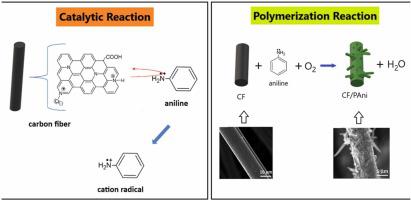Synthetic Metals ( IF 4.0 ) Pub Date : 2022-06-23 , DOI: 10.1016/j.synthmet.2022.117116 Aline Fontana Batista , Aline Castilho Rodrigues-Siqueli , Ana Paula Silva de Oliveira , Gilberto Petraconi , Maurício Ribeiro Baldan

|
Polyaniline (PAni) widely studied conductive polymer due to its incredible versatility, electrical properties, and low cost. PAni usually is produced by chemical or electrochemical synthesis. However, these processes either generate a large amount of waste or are expensive and produce a small amount. The catalytic system incorporated into the PAni synthesis can be a strategic way to develop clean and low-cost processes. Therefore, we propose a synthesis of PAni catalyzed by carbon fiber (CF) reported for the first time. The procedure is to immerse the CF in an aqueous solution of aniline and H2SO4, at room temperature, in an open flask. Tests were carried out to investigate the CF as a catalyst and the molecular oxygen as an oxidant in the polymerization reaction. The samples were characterized by scanning electron microscopy, Raman spectroscopy, infrared spectroscopy, and X-ray photoelectron spectroscopy. According to the analyses, the reaction catalysts are heteroatoms on the fiber surface. Molecular oxygen present in atmospheric air is the oxidant of the reaction. The method is environmentally friendly, simple, and economical route to produce a conductive form of PAni on carbon fiber. The composite produced was evaluated as a possible electrode for a supercapacitor, and presented interesting results for application in energy storage devices.
中文翻译:

碳纤维催化合成聚苯胺用于超级电容器
聚苯胺 (PAni) 因其令人难以置信的多功能性、电气性能和低成本而被广泛研究。PAni通常通过化学或电化学合成产生。然而,这些工艺要么产生大量废物,要么价格昂贵且产生量小。结合到 PAni 合成中的催化系统可以成为开发清洁和低成本工艺的战略途径。因此,我们提出了首次报道的由碳纤维(CF)催化的聚苯胺合成。该程序是将CF浸入苯胺和H 2 SO 4的水溶液中,在室温下,在开口烧瓶中。进行了测试以研究 CF 作为催化剂和分子氧作为聚合反应中的氧化剂。通过扫描电子显微镜、拉曼光谱、红外光谱和 X 射线光电子能谱对样品进行表征。根据分析,反应催化剂是纤维表面的杂原子。大气中的分子氧是反应的氧化剂。该方法是在碳纤维上生产导电形式的 PAni 的环保、简单且经济的途径。所生产的复合材料被评估为超级电容器的可能电极,并在储能装置中的应用中呈现出有趣的结果。











































 京公网安备 11010802027423号
京公网安备 11010802027423号